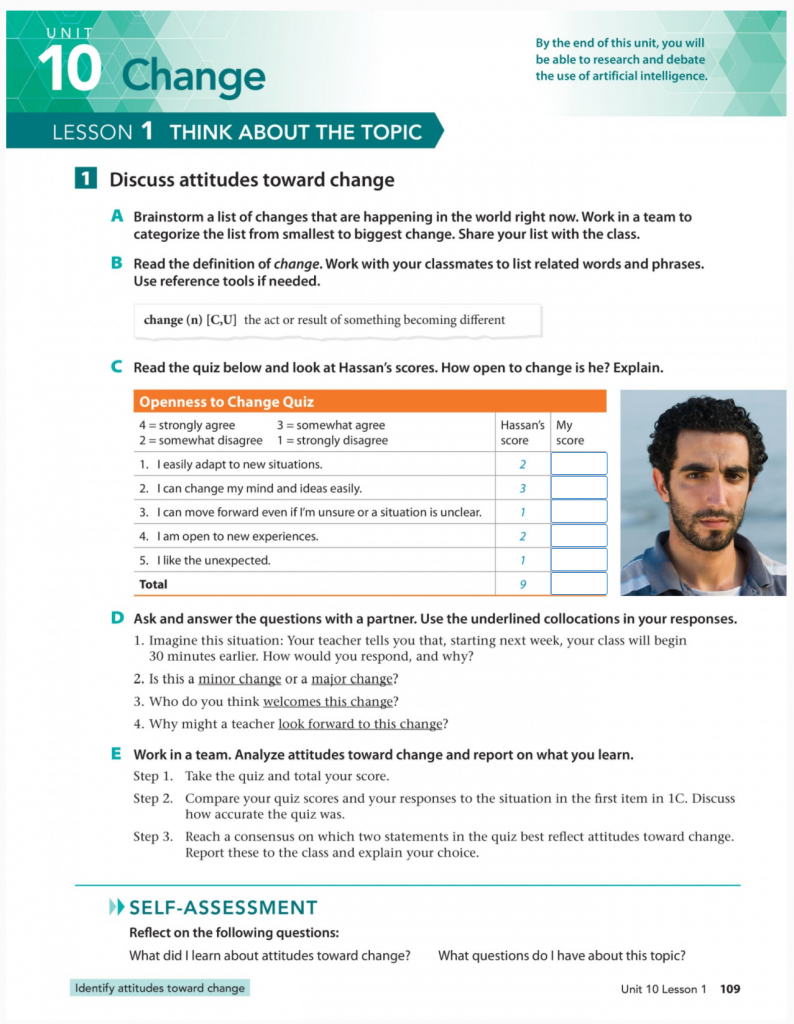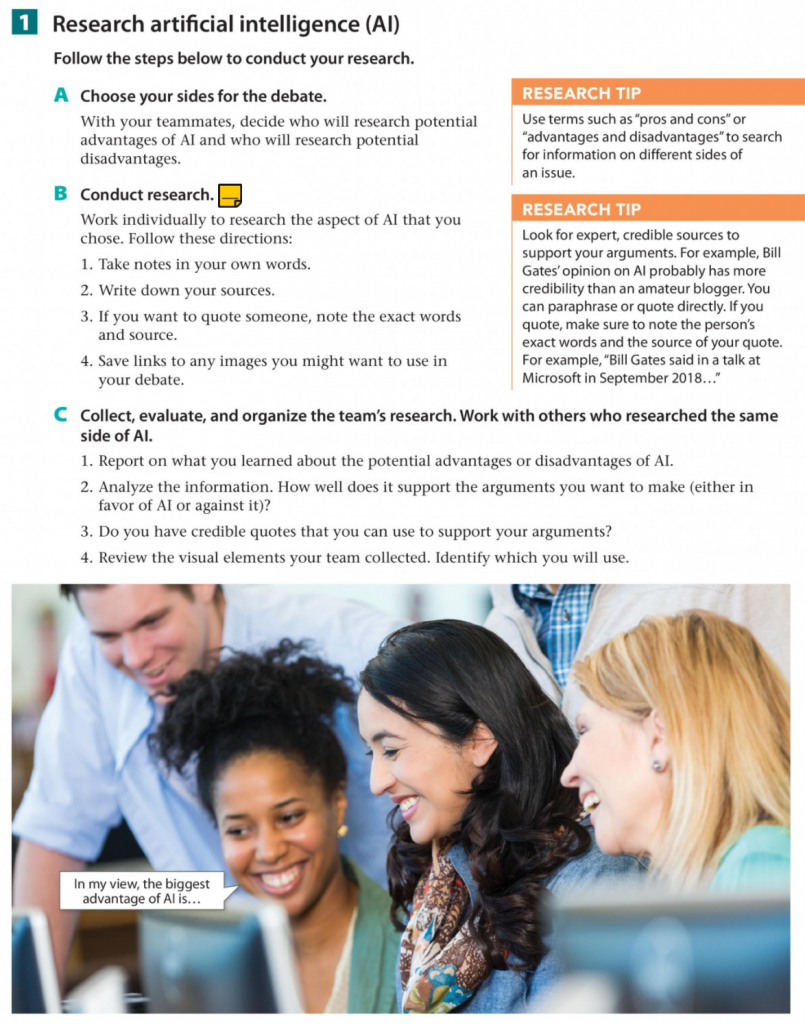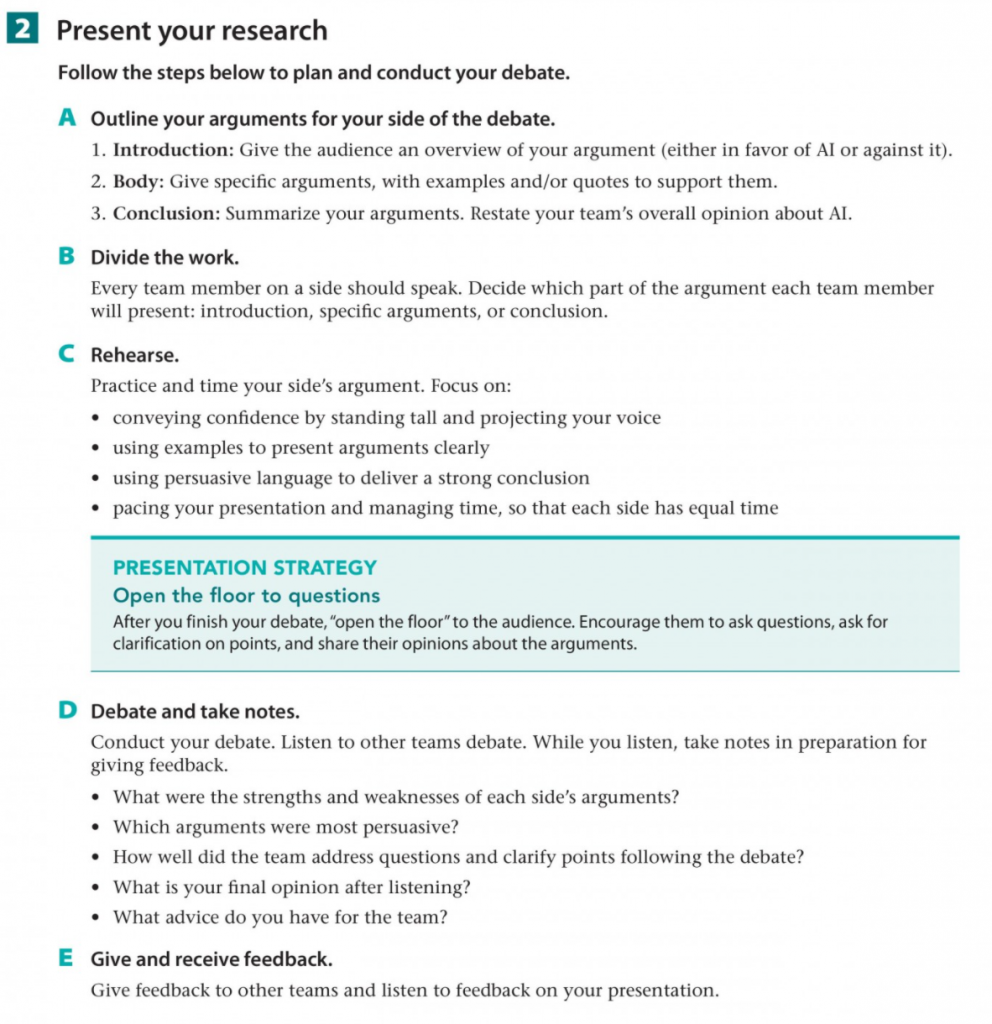Chapter Evaluation
Introduction
Unit 10 of Step Forward is entitled “Change” and can be found on page 109 of the textbook. There are six primary goals of the unit. First, students should be able to discuss technological changes in the workplace. Second, they should be able to identify the four stages of change: denial, resistance, exploration, and acceptance. Then, after the lesson on grammar, they should be able to properly use commonly confused words, such as effect and affect. They should also be able to integrate multi-word verbs using the Subject+Verb+Participle+Object form. The second to last goal is that students should feel comfortable summarizing a technical article using the writing process method. Finally, they should be able to conduct research and participate in a debate.
Activities
Unit 10 follows the same structure as the previous units:
Lesson 1: Think about the Topic
Lesson 2: Read and Listen
Lesson 3: Focus on Language
Lesson 4: Read and Discuss
Lesson 5: Write
Lesson 6: Team Research
Over the course of the unit, the activities become increasingly challenging and increasingly applicable. The activities associated with Lesson 1 are simple and discussion-based. Students work with partners to answer questions about attitudes toward change. In Lesson 2, students complete a reading comprehension activity and listening exercise. Lesson 3 activities are related to vocabulary and grammar. The subject matter is tricky, but the activities focus on acquisition rather than application. In comparison to Lesson 2 reading comprehension, the Lesson 4 article is much denser and the questions require more critical thinking. Lesson 5 has a writing assignment with a peer review element. The goal of this activity is to prepare students for the next activity. Lesson 6 Team Research project is a debate on artificial intelligence (AI). Students collaborate with classmates to research and debate the advantages and disadvantages of AI. They must apply what they have learned throughout both Unit 10 and the entire semester to complete the final project.
Effectiveness of Activities
I will be using Howard and Major’s “Guidelines for Designing Effective English Language Teaching Materials” as a metric to evaluate the effectiveness of Unit 10’s activities. According to the article, activities are not required to–and most likely will not–meet every guideline (Howard 104). However, effective activities often follow at least one of the guidelines.
Guidelines for Designing Effective English Language Teaching Materials
Howard and Major 104 -107
Guideline 1: English language teaching materials should be contextualised
Guideline 2: Materials should stimulate interaction and be generative in terms of language
Guideline 3: English language teaching materials should encourage learners to develop learning skills and strategies
Guideline 4: English language teaching materials should allow for a focus on form as well as function
Guideline 5: English language teaching materials should offer opportunities for integrated language use
Guideline 6: English language teaching materials should be authentic
Guideline 7: English language teaching materials should link to each other to develop a progression of skills,
understandings and language items
Guideline 8: English language teaching materials should be attractive
Guideline 9: English language teaching materials should have appropriate instructions
Guideline 10: English language teaching materials should be flexible
Step Forward Unit 10 does a fairly good job of explaining the activities and displaying the information in a colorful, yet professional way. Between the activities, there is a balance of teaching form and function. However, Unit 10’s greatest strengths lie in how well it follows guidelines 3, 6, and 7. The activities follow a logical path from easy to hard and from content to application. The last few activities build on each other and prepare the student to complete the final project: a researched team debate.
Although skills learned from Unit 10 Lesson 6 are very applicable, not every student will be interested in technology or studying AI for their degree. One improvement might be to allow students to choose a debate topic from a longer, more relevant list of options. Since the activity is flexible, this would be a simple modification.
Summary
Step Forward Level 5 is the last book in the series, and Unit 10 is the last unit of the textbook. Overall, the activities in this unit are useful and effective. Lesson 4 through 6 is especially applicable to college students, as they will be expected to conduct research by reading articles, writing papers, and orally presenting information in English. After successfully completing Unit 10, students should feel confident in a Freshman general education course. Advanced learners may even feel prepared for a senior or graduate-level class.
Works Cited
American Council of the Teaching of Foreign Languages, “5Cs of world-readiness standards for learning languages.” https://www.actfl.org/sites/default/files/publications/standards/World-ReadinessStandardsforLearningLanguages.pdf Accessed October 2021.
Howard, Jocelyn and Jae Major. “Guidelines for Designing Effective English Language Teaching Materials.” https://www.researchgate.net/publication/237476568_Guidelines_for_Designing_Effective_English_Language_Teaching_Materials. Accessed October 2021.
Adelson-Goldstein, Jayme, et al. Step Forward Level 5 Student eBook. 2nd ed., OUP Oxford, 2019.
WIDA. “ACCESS for ELLs Interpretive Guide.” https://wida.wisc.edu/sites/default/files/resource/Interpretive-Guide.pdf. Accessed October 2021.



